Unlock the vibrant flavors of Asian cuisine with this exceptional Chinese Broccoli recipe, also known as Gai Lan. This dish transforms humble leafy greens into a culinary masterpiece, featuring tender stalks and crisp leaves generously coated in a captivating garlicky ginger miso sauce. Designed for health-conscious food lovers, this recipe seamlessly fits into various dietary lifestyles, including vegan, Paleo, Whole30, Keto, and low-carb regimens. Prepare to elevate your weeknight meals and impress your palate with a dish that’s both incredibly nutritious and bursting with savory goodness. Grab your wok or a large skillet, and let’s embark on a delicious journey to create your new favorite Asian vegetable stir-fry.
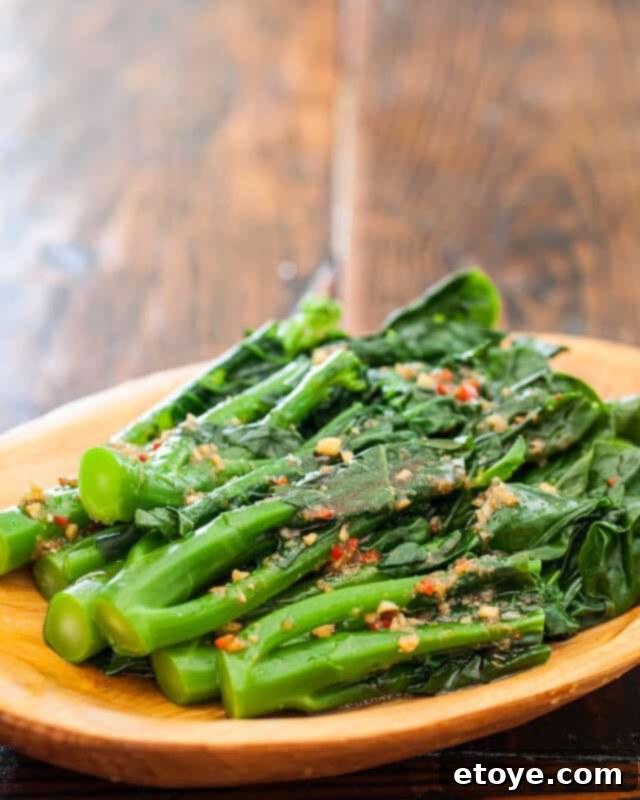
What You’ll Discover in This Recipe
- Expert tips on selecting the **freshest Chinese broccoli** for optimal flavor and texture.
- A unique cooking method that ensures **perfectly cooked stems and tender leaves**, preventing uneven results.
- How to master a **savory garlicky ginger miso sauce** that’s so versatile, it will become your go-to for countless vegetable dishes.
Why This Garlicky Ginger Miso Gai Lan Recipe is a Must-Try
This isn’t just another vegetable dish; it’s a testament to how simple ingredients can create an extraordinary culinary experience. Here’s why this Chinese broccoli stir-fry deserves a permanent spot in your recipe collection:
Lightning Fast & Effortlessly Easy
Forget the complexities of gourmet cooking. This Chinese broccoli recipe is specifically designed for speed and simplicity, making it the perfect solution for busy weeknights. With minimal prep and just a few minutes of cooking in a hot wok or large skillet, you can whip up a vibrant and flavorful dish that rivals your favorite takeout. Fresh ingredients like aromatic garlic cloves, pungent ginger, and umami-rich miso paste come together quickly, ensuring a delightful meal without the fuss or long wait times.
A Nutrient-Dense Powerhouse
Gai Lan, often referred to as Chinese kale, is celebrated not only for its distinct flavor but also for its impressive nutritional profile. Packed with essential vitamins, minerals, and dietary fiber, this leafy green vegetable offers a slightly bitter taste that provides a more complex and engaging experience compared to common American broccoli. Incorporating Chinese broccoli into your diet is a delicious way to boost your intake of vital nutrients, supporting overall health and well-being with every bite.
Unmatched Culinary Versatility
One of the greatest strengths of this Chinese broccoli dish lies in its incredible adaptability. Whether you serve it as a standalone side dish alongside fluffy white rice or wholesome brown rice, or integrate it into a larger stir-fry medley, this recipe always shines. It’s like the ultimate flexible ingredient, ready to complement any meal, from a comforting family dinner to a sophisticated potluck offering. Its robust flavor and satisfying texture make it a superb addition to almost any Asian-inspired feast.
Essential Ingredients for Your Chinese Broccoli Stir-Fry

Gather these fresh and flavorful components to create your delicious Gai Lan dish:
- Chinese broccoli (Gai Lan): The star of our dish, chosen for its unique texture and slightly bitter notes.
- Fresh ginger: Adds a warm, aromatic spice.
- Garlic: Provides a foundational pungent flavor, essential for Asian cooking.
- Chili peppers: Optional, but highly recommended for a delightful kick.
- Miso paste: Delivers deep umami and savory complexity to the sauce.
- Soy sauce: A fundamental seasoning for salty, savory depth.
- Cooking oil: For stir-frying and bringing out the aromatics.
- Asian sesame oil: A finishing oil for its distinctive nutty aroma and flavor.
- Water: To create the perfect steaming environment for the broccoli and to thin the sauce.
Step-by-Step Guide: Crafting Your Perfect Chinese Broccoli
Follow these simple steps to ensure your Chinese broccoli is cooked to perfection and infused with our signature garlicky ginger miso sauce.
1. Prepare the Chinese Broccoli for Even Cooking
Begin by thoroughly washing your Chinese broccoli. Line up the stalks with stems facing the same direction. The secret to evenly cooked Gai Lan lies in separating the thicker stems from the more delicate leafy parts. Carefully cut the stalks in half, creating two distinct sections. This ensures that the robust stems, which require longer cooking, can be placed closer to the heat source.
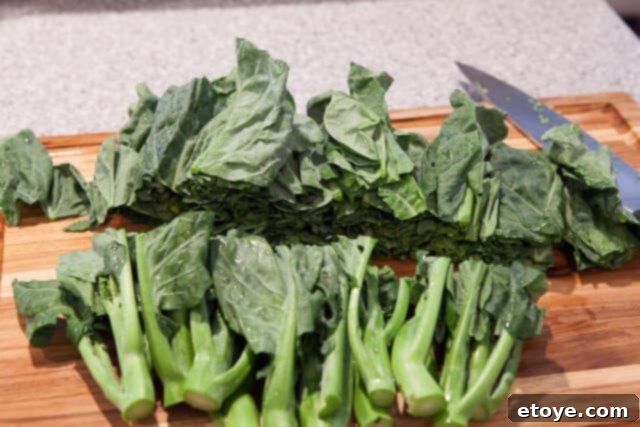
2. Steam the Stems First, Then the Leaves
Pour about one inch of water into your wok or a large sauté pan and bring it to a gentle simmer over medium heat. Carefully arrange the thicker Chinese broccoli stems at the bottom of the pan, ensuring they are in direct contact with the simmering water. Then, delicately layer the leaves on top of the stems. This clever layering technique allows the thicker stems to cook more thoroughly while the leaves steam to tender perfection without overcooking.
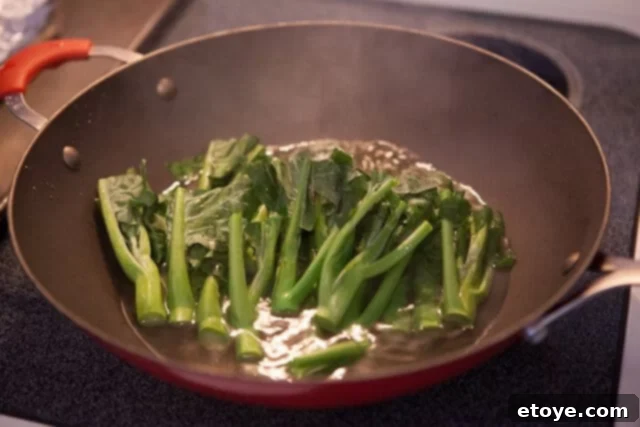
Lay the leaves on top, forming an even layer.

3. Cover and Steam
Cover the wok tightly with a lid and let the vegetables steam for approximately 3 minutes. After this time, use tongs to carefully transfer the cooked leaves to a serving plate. Check the stems for doneness by piercing them with a knife; they should be easily tender. If the stems are particularly thick, they might need an additional minute or two of steaming. Once cooked, add them to the plate with the leaves.
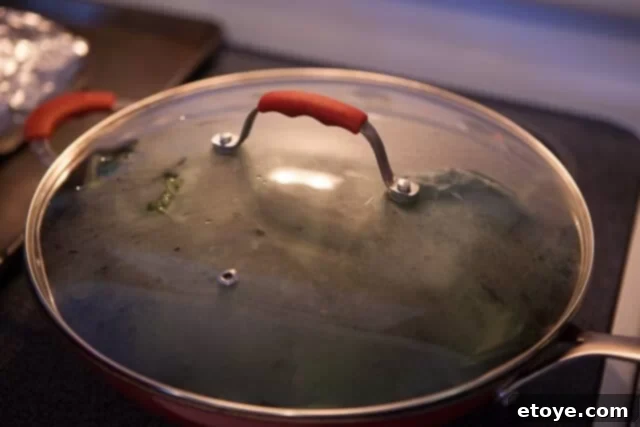
4. Prepare the Garlicky Ginger Miso Sauce
Once the Chinese broccoli is cooked and plated, remove any remaining water from the wok and thoroughly wipe it dry with a towel. This crucial step prevents oil splatters when you add the cooking oil. Return the dry wok to the stove and add the cooking oil, followed by the grated fresh ginger, minced garlic, and optional minced chili pepper. Turn the heat to medium-low. As the oil begins to shimmer, stir-fry the aromatics for about 15 seconds, being careful not to burn them – just long enough for their fragrant oils to be released.
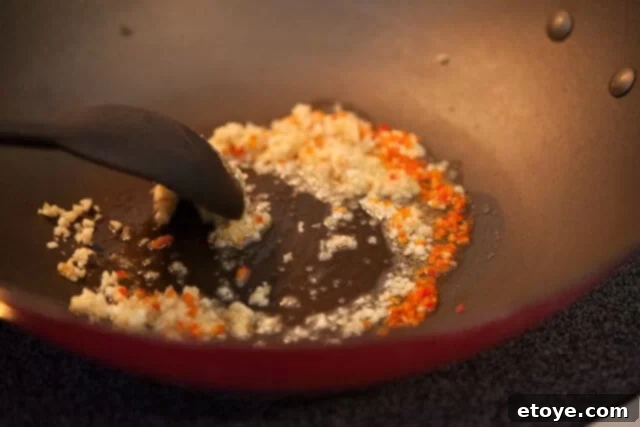
Next, stir in the miso paste, water, soy sauce, and Asian sesame oil. Continue to cook for another 15 seconds, allowing the sauce to gently simmer and meld its flavors. The aroma at this stage will be incredibly inviting!
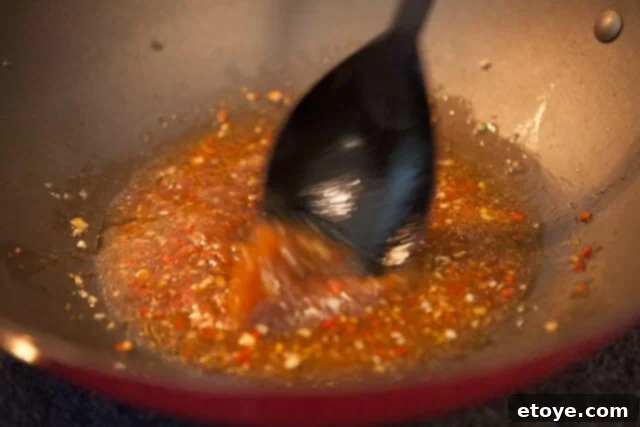
5. Combine and Serve
Finally, return the steamed Chinese broccoli to the wok with the simmering sauce. Give everything a quick, gentle stir to ensure all the greens are beautifully coated. Transfer the dressed Chinese broccoli to your serving plate and serve immediately. Enjoy this vibrant, flavorful, and healthy dish!
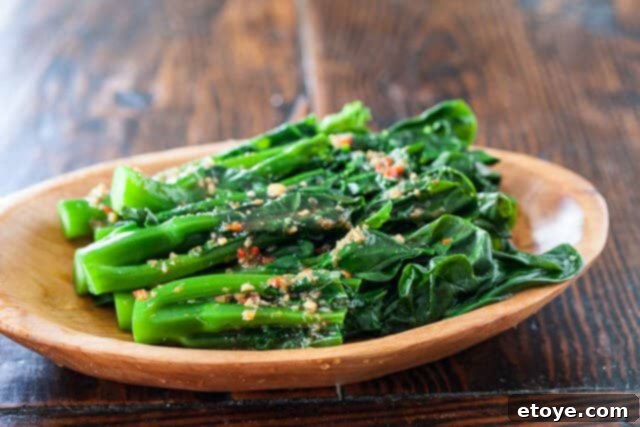
What Exactly is Chinese Broccoli (Gai Lan)?
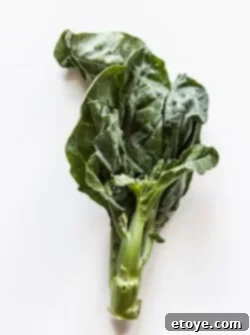
Chinese broccoli, known as Gai Lan or Kai Lan (pronounced “guy-LAN”) in Cantonese, is a distinct leafy green vegetable within the Brassica family, a close relative to the common broccoli we often see in Western supermarkets. However, its characteristics and culinary applications set it apart. Unlike its tree-like cousin with large florets, Gai Lan typically features thick, flat, blue-green leaves and sturdy stems, often with small, unopened flower buds.
Its flavor profile is more assertive than regular broccoli, boasting a delightful balance of bitterness and subtle sweetness, which becomes milder and more pleasant upon cooking. While raw Gai Lan can be quite bitter, cooking transforms it into a tender, succulent vegetable with a satisfying chewiness. In traditional Chinese cuisine, the entire plant – stems and leaves – is enjoyed, and it’s a staple in dishes ranging from simple stir-fries to elaborate dim sum platters.
An interesting fact: Broccolini, a popular green often mistaken for baby broccoli, is actually a hybrid cross between conventional broccoli and Gai Lan, inheriting desirable traits from both parents.
How to Select the Freshest Chinese Broccoli
For any Chinese broccoli recipe, especially one as vibrant as this garlicky ginger miso creation, freshness is paramount. The quality of your Gai Lan directly impacts the texture and flavor of the final dish. Here’s how to ensure you’re picking the best at the market:
- **Examine the Florets:** The most telling sign of fresh Chinese broccoli is the minimal presence of open florets. Look for tight, unopened buds. If you see small white or yellow flowers blooming, it generally indicates the vegetable is past its prime. These older stalks tend to be tough, stringy, and much more bitter than desired.
- **Inspect the Stems:** Pay close attention to the cut ends of the stems. Fresh, young Chinese broccoli will exhibit a moist, almost milky-translucent appearance in the center of the stem. This signifies high moisture content and tenderness. In contrast, older Gai Lan will have a dried-up, hard, and opaque white center. Avoid these; they will be fibrous and lack the desired crisp-tender bite.
- **Color and Leaf Condition:** The leaves should be a vibrant, deep blue-green color, without any yellowing or wilting. They should look crisp and firm, not limp or bruised.
Here’s a photo of fresh Gai Lan with a soft, opaque-ish milky center, indicating prime freshness:
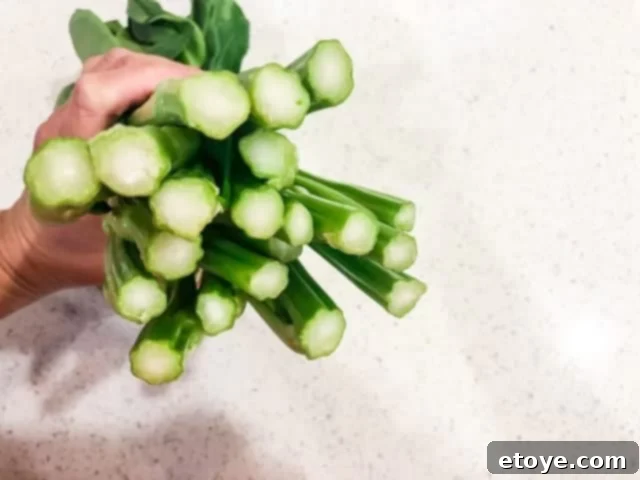

The Remarkable Health Benefits of Chinese Broccoli
Beyond its delicious taste, Chinese broccoli is a nutritional powerhouse, making it an excellent addition to any balanced diet. Like many dark leafy green vegetables, Gai Lan is packed with essential vitamins and minerals that contribute to overall health:
- Rich in Beta Carotene: Chinese broccoli is an excellent source of beta carotene, a powerful antioxidant that the body converts into Vitamin A. Vitamin A is crucial for maintaining healthy vision, protecting against age-related macular degeneration (ARMD), which is a leading cause of vision loss and eventual blindness.
- High in Vitamin E: This green vegetable also provides significant amounts of Vitamin E, another potent antioxidant. Vitamin E plays a vital role in boosting immune function, helping your body defend against viral and bacterial infections. It also supports skin health and acts as an anti-inflammatory agent.
- Abundant in Dietary Fiber: As a great source of dietary fiber, Chinese broccoli aids in digestive health, promoting regularity and preventing constipation. Fiber also contributes to satiety, helping with weight management, and can help regulate blood sugar levels.
- Contains Vitamin C and K: While not explicitly mentioned in the original text, like most cruciferous vegetables, Gai Lan is also a good source of Vitamin C (for immune support and skin health) and Vitamin K (essential for blood clotting and bone health).
Incorporating Chinese broccoli into your meals is an effortless way to enhance your nutritional intake and enjoy a delicious, health-promoting food.
Top Tips for Mastering This Chinese Broccoli Recipe
Achieving the perfect texture and flavor in your Gai Lan stir-fry is simple with these expert tips:
- **Strategic Stem Placement:** Remember that Chinese broccoli stems are thicker and denser than the leaves. To ensure even cooking, always place the stems at the bottom of your wok or pan, where the heat is most intense. This allows them to become tender-crisp while preventing the more delicate leaves from overcooking and becoming mushy.
- **Dry Wok for Sizzle, Not Splatter:** Before adding your cooking oil and aromatics, it’s crucial to completely wipe the wok dry after steaming the vegetables. Any residual water will cause the oil to splatter vigorously, which can be messy and dangerous. A dry wok ensures your aromatics sizzle beautifully and infuse the oil with maximum flavor.
- **Spotting Freshness in Stems:** When selecting Chinese broccoli, look for stems with a wet, milky-translucent color in their center. This is a reliable indicator of young, fresh Gai Lan that will be tender and flavorful. Avoid stems with a dry, opaque white center, as these are typically older and tougher.
- **Versatile Greens & Sauce:** Don’t limit this fantastic sauce to just Chinese broccoli! This garlicky ginger miso sauce is incredibly versatile and pairs wonderfully with a variety of Asian vegetables. Consider substituting Gai Lan with broccolini, yu choy, bok choy, or even regular broccoli florets. The same seasoning base also works exceptionally well with spinach or other leafy greens, offering endless possibilities for delicious, healthy stir-fries.
Chinese Broccoli FAQs
What exactly is Chinese broccoli, and how does it differ from regular broccoli?
Chinese broccoli, known as Gai Lan or Chinese kale, is a leafy green vegetable that is a close relative of standard American broccoli. However, it boasts distinct characteristics. Unlike common broccoli with its prominent, tight florets and thick main stem, Gai Lan features long, flat, blue-green leaves, tender stems, and small, open flower buds. Its flavor is notably more robust and has a slightly bitter undertone compared to the milder taste of regular broccoli. It’s a fundamental vegetable in many Chinese culinary traditions, particularly in stir-fries and dim sum dishes.
Can I find the ingredients for this recipe at regular grocery stores?
Many of the core ingredients, such as cooking oil, soy sauce, fresh garlic, and ginger, are widely available in most standard grocery stores. However, for authentic Chinese broccoli and a broader selection of specialized items like various miso pastes or specific Asian sesame oils, you’ll likely have the best luck at an Asian grocery store. These markets often carry a wider range of high-quality ingredients essential for creating true Asian flavors.
Is this recipe suitable for a vegetarian or vegan diet?
Absolutely! This Chinese broccoli dish is a fantastic choice for both vegetarians and vegans. It is inherently plant-based, using no animal products. To ensure it remains fully vegan, simply verify that your miso paste and any other sauces (like an optional vegetarian oyster sauce, if you choose to add it for extra umami) are free from animal-derived ingredients. It’s a delicious and nutritious addition to any plant-based meal plan.
What kind of miso paste should I use for this recipe?
While any type of miso paste will lend a savory depth, white miso (shiro miso) or yellow miso (shinshu miso) are generally recommended for this recipe. White miso offers a milder, sweeter, and more delicate umami flavor, perfect for highlighting the fresh greens. Yellow miso has a slightly stronger, earthier flavor. Red miso (aka miso) is typically more pungent and salty, which might overpower the delicate notes of the Gai Lan, so use it sparingly or if you prefer a bolder flavor profile.
Can I use a substitute for Chinese broccoli if I can’t find it?
Certainly! While Gai Lan offers a unique taste and texture, if it’s unavailable, you can use several alternatives. Broccolini is an excellent choice as it’s a cross between broccoli and Gai Lan, offering a similar tender-crisp texture. Broccoli rabe (rapini) or even hearty kale can also work well, providing a similar leafy green experience with a slightly bitter edge. Remember that cooking is an art of adaptation, so feel free to experiment to find what best suits your palate and local availability.
What type of rice works best with this dish?
This Chinese broccoli recipe is incredibly adaptable and pairs wonderfully with almost any type of rice. Classic white rice, such as jasmine or basmati, provides a neutral base that perfectly complements the savory sauce. Brown rice offers a nuttier flavor and added fiber, making for a heartier meal. For an interesting contrast, you could even serve it with a small bowl of sweet rice. Ultimately, the best choice is the one you enjoy most!
How long can I store leftovers, and how should I reheat them?
Leftover Chinese broccoli with garlicky ginger miso sauce can be stored in an airtight container in the refrigerator for up to 2-3 days. To reheat, gently warm it in a wok or skillet over medium heat for a few minutes until heated through. You can also microwave it, but be careful not to overcook, as the greens can become mushy. A quick stir-fry reheating often helps retain a better texture.
More Delicious Chinese Vegetable Recipes to Explore
If you loved this Chinese broccoli recipe, be sure to try these other fantastic Asian vegetable dishes:
- Chinese Broccoli with Oyster Sauce
- Chinese Yu Choy Stir Fry
- Stir Fried Bok Choy Recipe
- Chinese Broccoli Beef Noodle Stir Fry
We hope you thoroughly enjoy creating and tasting this exquisite Chinese Broccoli with Garlicky Ginger Miso Sauce. Your feedback is incredibly valuable to us! Please feel free to leave a star rating and share your thoughts and experiences in the comments section below. Happy cooking!
Chinese Broccoli with Garlicky Ginger Miso Recipe
By Jaden
If you don’t have Chinese broccoli, feel free to use any other greens like asparagus, broccoli, broccolini, broccoli rabe, mustard greens, napa cabbage, bok choy, etc.
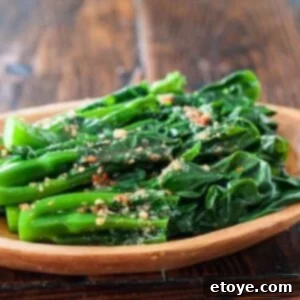
Average Rating: 5 from 3 votes
Print Recipe
Pin Recipe
Prep Time: 5 mins
Cook Time: 10 mins
Total Time: 20 mins
Course: Side Dish
Cuisine: Asian
Servings: 4 people
Calories: 130 kcal
Ingredients
- 1 pound Chinese broccoli (gai lan)
- 2 tablespoons cooking oil
- 1 teaspoon grated fresh ginger
- 2 cloves garlic (finely minced)
- 1 teaspoon hot chili pepper (minced, optional)
- 1 1/2 tablespoons miso paste
- 2 tablespoons water
- 1 tablespoon soy sauce
- 1 teaspoon Asian sesame oil
Instructions
- Trim ends of the Chinese broccoli. Line up the Chinese broccoli with the stems facing same direction. Cut the stalks in half to separate the thick stems from the leaves.
- Add one inch of water to a wok, pot or large saute pan and bring to a simmer on medium heat. Layer in the broccoli stems at the bottom of the pan and layer the leaves on top of the stems. You want the thick stems closer to the bottom of the pan so that they will cook faster. Steam for 3 minutes. Use tongs to lift the leaves to a plate. Check the stems to make sure they are cooked – they should be easily pierced with a knife. Thicker stems might need an additional minute.
- Discard the remaining water in the pan and wipe dry with a towel. Return pan to the stove and add in the cooking oil and ginger, garlic and chile pepper. Turn the heat to medium-low. Once the oil in the wok begins shimmering, cook for another 15 seconds (take care not to burn the aromatics). Stir in the miso paste, water, soy sauce and sesame oil and cook another 15 seconds. Add the Chinese broccoli back into the pan, give everything a quick stir, then plate for serving.
Notes
- The broccoli stems are thicker and should go at the bottom of the pan, to cook evenly.
- Wipe off the water from the wok before you stir in the aromatics, this will prevent splattering.
- Fresh young Chinese broccoli will have a wet-milky-translucent-ish color in the center of the stem.
- You can substitute Chinese broccoli for broccolini. You can also use the same ingredients and sauce for almost all Asian vegetable stir-fries, for example, yu choy. The same seasonings also work for spinach and broccoli.
Nutrition
Calories: 130 kcal, Carbohydrates: 9g, Protein: 4g, Fat: 8g, Sodium: 360mg, Potassium: 8mg, Fiber: 1g, Sugar: 3g, Vitamin A: 2000IU, Vitamin C: 106.3mg, Calcium: 83mg, Iron: 1.1mg
Tried this recipe?
Let us know how it was!
